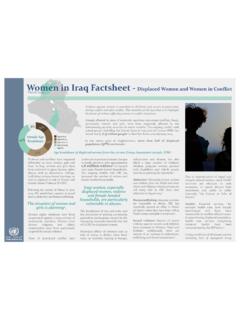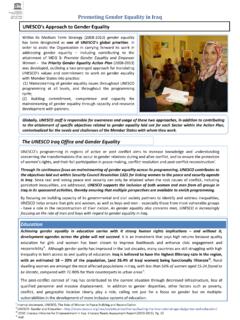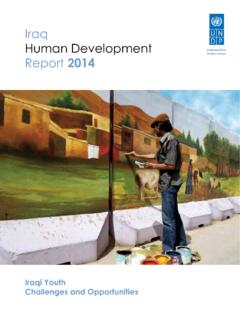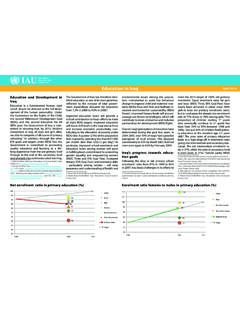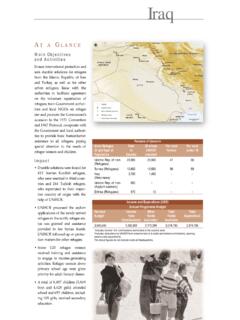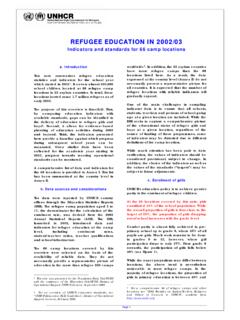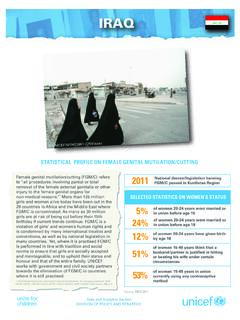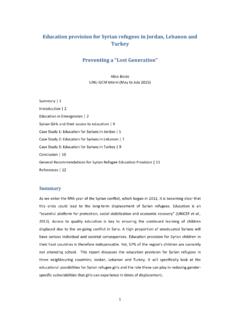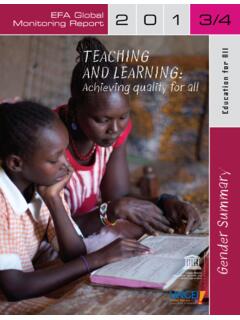Transcription of Decline of Iraqi women - BRussells Tribunal
1 BRussells Tribunal 1 Decline Of Iraqi women Empowerment Through education Under the American Occupation of iraq 2003-2011 Souad Al-Azzawi, Associate Professor. Baghdad, iraq . Paper presented in International Seminar on the Situation of the Iraqi Academics. Ghent University, Belgium. March 9-11, 2011. Summary: The real women population empowerment in Iraqi society started during the sixties and seventies of the last century. This empowerment was effectively implemented by secular Iraqi governments through education . The three basic legislations like the Eradication of Illiteracy Law of 1971, the Free education Law of 1974 in all levels including higher education , and the Compulsory education Law of 1978 with other supporting legislations, pushed women in iraq to pursue their economical, civil, and political rights.
2 Within two decades, women s status in iraq was transformed to a new advanced level compared to the surrounding countries in the region. Illiteracy amongst women dropped from 91% in 1957 to 12% in 1990. During the 1990's, women faculty members in Iraqi universities and research centers made up more than 30% of total faculty members in iraq . About 67% of all teaching staff in primary, secondary, and high schools in iraq were women during the eighties. One major setback in women s rights status in iraq started after the destruction of all civilian infrastructure including education centers by US-UK air raids and military operations in Gulf War1 of 1991. The imposition of comprehensive economical sanctions on Iraqi population from 1991 till the occupation of iraq by USA in 2003 also played a major role in slowing down women s progress.
3 Other factors include; the second destruction of all services and infrastructure during iraq 's invasion military operations of 2003, solving the Iraqi army and security forces by occupation left the country in total chaos. Thousands of people were and still being killed, including women and children. Other tens of thousands are detained. With kidnapping, assassination of academics, teachers, health care specialists, and most of other professionals, it becomes really hard for women to keep up their jobs and education status. The American occupation of iraq have ended more than forty years of efforts to improve women status in iraq . According to OCHA 2007 women Illiteracy crawled back to more than 50% in most of Iraqi governorates, unemployment among women rose to more than 50%, and real Decline in all other related parameters.
4 Fundamentalism of the occupation appointed government pulled the women rights back to the dark ages. Occupation's women 25% (quota) in the Iraqi Perlman is only symbolic political representation. It improves the occupation image. Green Zone (Quota) women represent the occupation and not Iraqi women population. Data and figures in this report proves that the Decline of Iraqi women empowerment have started and staged through 20 years of consecutive American aggressions as part of the plan to destroy the Iraqi society and state to control its oil and other resources. BRussells Tribunal 2 Background of education in iraq : iraq was under the rule of the Ottoman Empire for four centuries.
5 Towards the end of this period, around World War I, the literacy rate in iraq did not exceed [1]. After WWI, iraq was under British occupation. From that time and until 1958, the illiteracy rate was at [1]. iraq had partial independence from British rule in 1920. In 1921, iraq began establishing its educational system. One of the most important accomplishments during that period was the establishment of some higher education organizations specializing in medicine, engineering, law, and the arts [2]. These became the colleges of the University of Baghdad in 1957. The Republic of iraq was established in 1958. The country succeeded in reallocating 45% of its oil revenues from foreign oil companies.
6 During that time, Iraqis managed to raise the literacy levels to 30% of the adult population [2]. During this era also, education was made mandatory but no real enforcement. It was only in the 1970s, under Al Bath party, when iraq witnessed the establishment of a free educational system inclusive of all stages of education from primary school, up to the higher education level. The education policy of the country was set by three laws passed during the 1970s [1]: - The Illiteracy Eradication Law, 1971 - The Free education Law, 1974 - The Compulsory education Law, 1978 The Compulsory education Law made primary education compulsory for all Iraqis, at least the first six years. This was ground-breaking in both iraq , and the region.
7 It enforced education for all Iraqis at varying social and economical levels, in addition to ensuring an equal opportunity for Iraqi girls within the educational system. In 1978, the Iraqi government launched the National Comprehensive Campaign for Eradication of Illiteracy which was a campaign launched among Iraqis between the ages of 15 to 45. When the Iraqi government nationalized all oil company shares in 1973, public income reached nearly 36 billion dollars in 1978 and continued to rise until 1981. Thus, iraq was able to develop its education both horizontally and vertically and to raise the country from illiteracy by 1985, in accordance with the classification of UNESCO [2]. By 1984, the rise of gross enrollment rate exceeded 100%, and a complete gender parity was achieved in enrolment (UNESCO, 2000).
8 In 1982, iraq won the UNESCO prize for eradicating illiteracy [1]. UNESCO Fact Sheet (March, 2003) stated: The education system in iraq prior to 1991 was one of the best in the region, with over 100% gross enrolment rate for primary schooling, and a high level of literacy, both of men and women . The Higher education , especially the scientific and technological institutions, were of an international standard, staffed by high qualification personnel [3] BRussells Tribunal 3 High education in iraq followed the same pattern as primary and secondary education . Table (1) shows the sequence of universities established due early 1900 s to 1970 [4]. Table 1: Sequence of Iraqi Universities Established Through the Period from 1908-1970.
9 Name of University Year Established City College of Law * 1908 Baghdad Higher Teachers Training College * 1923 Baghdad College of Medicine * 1927 Baghdad College of Pharmacy * 1936 Baghdad College of Engineering * 1942 Baghdad Mustansiriya University 1963 Baghdad University of Technology 1960 Baghdad University of Baghdad 1957 Baghdad University of Basrah 1967 Basrah University of Mosul 1963 Mosul University of Sulaimaniyah 1968 Sulaimaniyah *Five colleges shown in table 2 became the University of Baghdad in 1957 [4]. 1. Role of education on women s Status in iraq Prior to 1920, Iraqi women s rights were not truly recognized under the Ottoman Empire rule. Under the British occupation of iraq , after World War I, the situation did not improve much.
10 The first move towards paid employment of women in iraq occurred with the opening of the Teachers Training Institute in 1923 [5], where women worked as teachers, nurses, and office employees. During the 1940s and 1950s, subsequent women s organizations were connected to the underground opposition like the communist party and Al Ba'ath party . In the late 1960s, the Ba ath Party started an ideological campaign for women s participation in the labor force and the educational system [5]. Based on the idea of modernization, the campaign insisted that women should play a crucial role in the national revolution. Massive education campaign of Iraqi girls was carried in the 1970s. The educational level amongst Iraqi women improved greatly as a result of the free and compulsory education policies.
